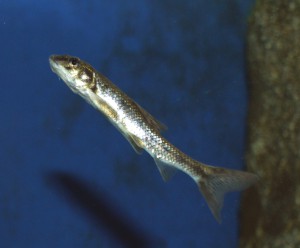 Gudgeons live all across Europe, except for its north and south, all the way to the upstream Lena; they are also present in the Amur watershed, though absent from other rivers of the Pacific coast. The gudgeon inhabits rivers of slow or average-speed current over sandy or gravelly beds, brooks and running ponds. It grows up to 22 cm, but species longer than 15 cm are rare. It is a small fish distinct from others in appearance: its body is greenish brown on top, silvery on the flanks with bluish and black spots sometimes merging into a dark stripe, and the belly is silvery with yellowish hue; the dorsal and caudal fins are rippled with black dots, and the others are grayish. There are barbs in the mouth corners. This coloration is great camouflage for a bottom fish. Gudgeons are typical benthos eaters: their fry start by feeding on small bottom crustaceans – rhizopods and rotifers; as they grow they turn on to larvae of tendipedini, dayflies and small pea-crabs. Their diet is possibly restricted to the bottom food. For instance, when dayfly larvae take to the air with most fish starting to prey on them, gudgeons continue to feed on tendipedini larvae. In spring, gudgeons eat vast amounts of fish roe. Through their lives, they stick to large schools. On a shiny day, gudgeons can be seen hovering still from shore – their appearance is also so peculiar that it is really easy to tell them from any fish. The head and the fairly big pectoral fins stuck out makes the front part of the fish look triangular. Gudgeons mature in year 3-4, being over 8 cm long. Their spawning is intermittent and takes one and half or two months. They breed in shallow waters over stones, sometimes in thickets of water crowfoot, splashing noisily by hitting water with their tails. The roe is firmly attached to the substrate and incrusted with pieces of ooze and sand grains, thus becoming barely visible. Over some time, fry with huge pectoral fins and well-developed eye pigment hatch. They do not dread light and lie still on the sunlit bottom, supported by the pectoral fins. The fish is of no commercial value. In certain waters it is an important element in the diet of predating fish.
Gudgeons live all across Europe, except for its north and south, all the way to the upstream Lena; they are also present in the Amur watershed, though absent from other rivers of the Pacific coast. The gudgeon inhabits rivers of slow or average-speed current over sandy or gravelly beds, brooks and running ponds. It grows up to 22 cm, but species longer than 15 cm are rare. It is a small fish distinct from others in appearance: its body is greenish brown on top, silvery on the flanks with bluish and black spots sometimes merging into a dark stripe, and the belly is silvery with yellowish hue; the dorsal and caudal fins are rippled with black dots, and the others are grayish. There are barbs in the mouth corners. This coloration is great camouflage for a bottom fish. Gudgeons are typical benthos eaters: their fry start by feeding on small bottom crustaceans – rhizopods and rotifers; as they grow they turn on to larvae of tendipedini, dayflies and small pea-crabs. Their diet is possibly restricted to the bottom food. For instance, when dayfly larvae take to the air with most fish starting to prey on them, gudgeons continue to feed on tendipedini larvae. In spring, gudgeons eat vast amounts of fish roe. Through their lives, they stick to large schools. On a shiny day, gudgeons can be seen hovering still from shore – their appearance is also so peculiar that it is really easy to tell them from any fish. The head and the fairly big pectoral fins stuck out makes the front part of the fish look triangular. Gudgeons mature in year 3-4, being over 8 cm long. Their spawning is intermittent and takes one and half or two months. They breed in shallow waters over stones, sometimes in thickets of water crowfoot, splashing noisily by hitting water with their tails. The roe is firmly attached to the substrate and incrusted with pieces of ooze and sand grains, thus becoming barely visible. Over some time, fry with huge pectoral fins and well-developed eye pigment hatch. They do not dread light and lie still on the sunlit bottom, supported by the pectoral fins. The fish is of no commercial value. In certain waters it is an important element in the diet of predating fish.
/ * The photos at lake.peipsi.org are cross-posted from commons.wikimedia.org and are used for familiarization purposes only. No commercial use of the photos is allowed. For more information about to use the photos see the originals on commons.wikimedia.org. /


